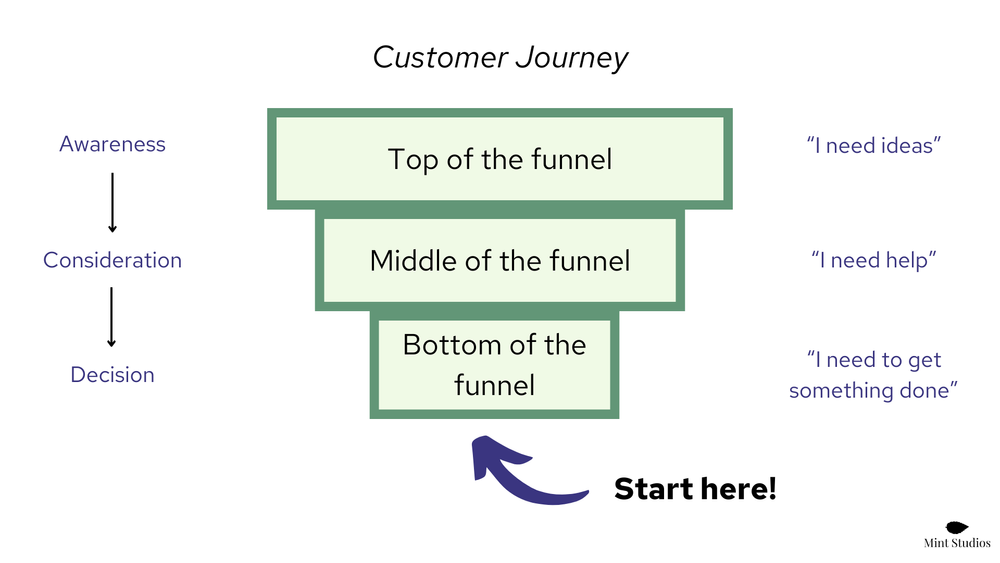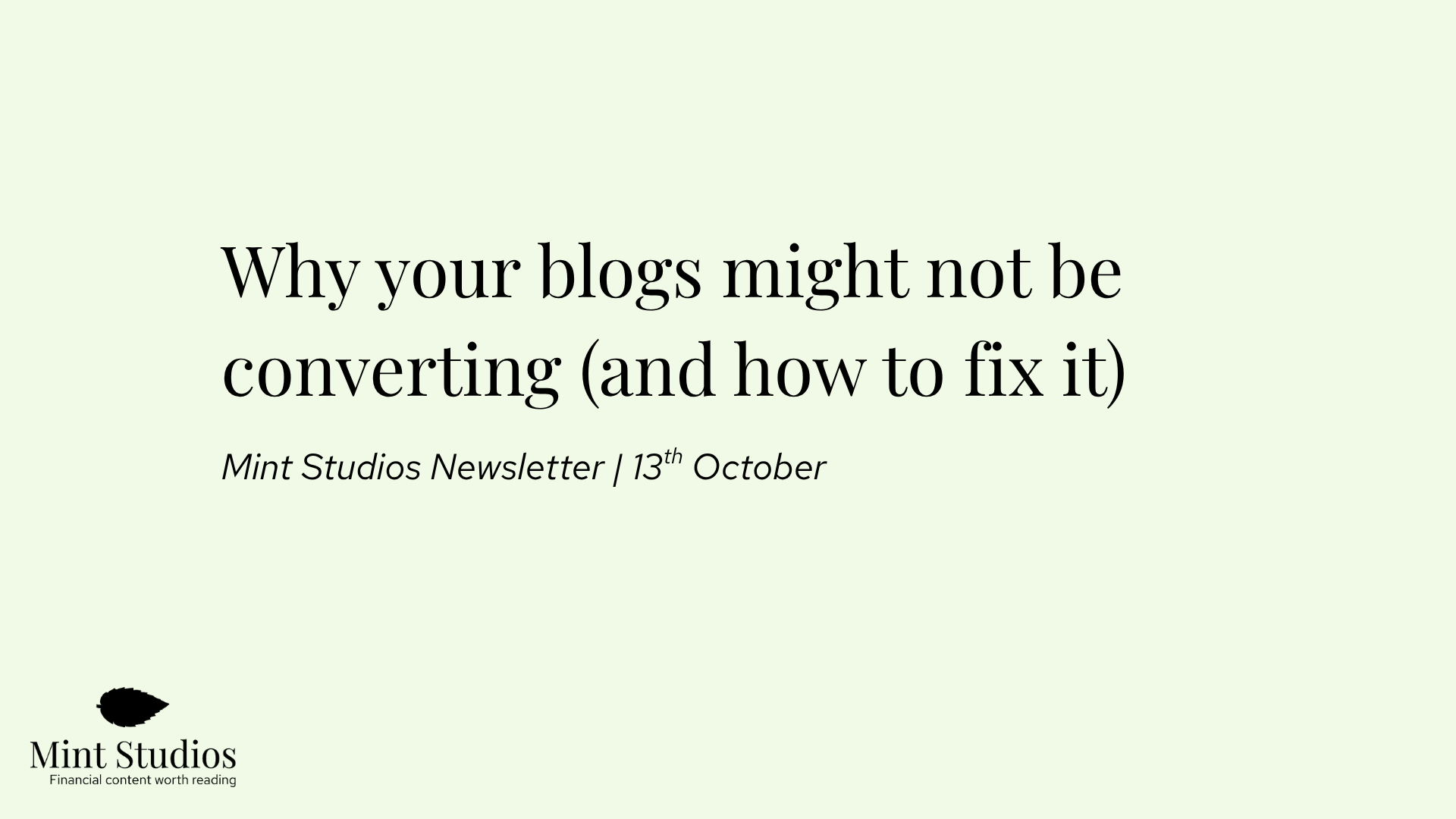When we first talk to a prospect for our agency, we always ask the team this question:
“Fast forward 3 years. Say you’re very happy with the success of what you’re doing and of your content marketing. What does that look like in practice?”
We usually hear, in some way, these two answers:
- We’re getting a good number of inbound leads on a regular basis.
- We’re seen as thought leaders in the industry.
Traditionally, content marketing is used for the second answer: to build a brand and be seen as thought leaders.
Very few content marketing agencies focus on the first answer: helping you get prospects and customers in the door.
At Mint Studios, we saw an opportunity to help companies with the first answer, and that’s part of the reason we created our agency: to help fintech companies use content specifically for customer acquisition. In 2023, profitability and revenue take priority over brand, so the type of content we create is a lot more useful to marketing teams that need to report on revenue to their leadership team.
With our framework using Bottom of the Funnel content, we use content to bring in customers – and can track and prove it using Hubspot or Google Analytics.
However, what’s great about the content we create – BOFU content – is that it doesn’t just help you with customer acquisition. It also helps with thought leadership, brand awareness, education and so much more (and therefore, the second answer we get from prospects).
We know that customer acquisition will always be the primary goal, and we’ll always help our clients with exactly that. But it would be stupid to not admit the huge other benefits of BOFU content marketing. That’s what we’ll dive into in this article.
If you’re new to Bottom of the Funnel content and aren’t sure what it entails, we recommend reading this post: What is BOFU (Bottom of the Funnel) Content and Why Is it Important?
Note: get updated every time we publish an article by joining our fortnightly newsletter!
Benefit 1: BOFU content will help you acquire high-quality leads that convert higher
When people think of lead generation via content, they usually think of adding gated content to a high traffic post and calling that lead generation. But these leads won’t be high quality: downloading an eBook doesn’t mean you’re ready to buy.
With BOFU content, we are targeting a particular subset of people: people who are actively looking for a solution to their problem. Because of their intent (ready to buy) they actively want to talk to a salesperson and are ready to convert. That’s worth a lot more than someone who just downloaded an eBook and didn’t say they wanted to talk to a salesperson.
This is a big problem with outbound sales and classic lead generation tactics: you’re targeting people who don’t have a problem yet, aren’t aware and aren’t looking. With outbound sales, you’re really doing outbound marketing: you’re raising awareness, but they aren’t ready. That’s why fintech sales cycles can be so long.
When we create BOFU content with our framework, we’re using SEO as a primary channel. In other words, we’re creating content that’s ranking for keyphrases that we believe customers who are close to converting are looking for.
We believe that when it comes to content marketing, it makes more sense to first target the people who are close to converting, and then work your way up the funnel. If not, you’re not capturing any of the demand you’re creating and you’re missing out on potential revenue.

For our client, Jeeves, a corporate expense solution, we were targeting keyphrases like:
- Accounts payable software
- Spend management for finance teams
- Corporate expense cards
For our client, Zai, a payment orchestration company, we were targeting keyphrases like:
- BSB validation API
- Top direct debit solutions
- Healthcare payment processing solution
For our client, William Russell, an insurance company for expats, we were targeting phrases like:
- Best insurance for working abroad
- Health insurance Botswana
- Life insurance for expats in Japan
These phrases are very different to typical TOFU content, like:
- What is corporate expense management?
- Direct debit vs bank to bank transfers
- Best online groups for expats
People who are typing up the BOFU phrases are clearly looking for a solution to their problem, and are likely to be ready to buy.
We then use Google Analytics and Hubspot to track the people coming in through our blog content. We usually track with:
- First click
- Last click
- Linear attribution
Because we use Hubspot, we can see the contacts that come in via our blog articles and can track the conversion rates and even the size of the deal that we brought in.

You can read more here: Case Study: How We Helped Zai Gain Multiple SQLs Per Month with Content
With BOFU content, you’re not just acquiring customers. You’re acquiring customers that are more likely to buy because they are lower down in the funnel, which means conversion rates are usually a lot higher.
Benefit 2: BOFU content helps raise awareness amongst highly qualified prospects
What’s great about content and SEO is that you can also choose to create content for the whole marketing funnel, middle and top included.
If you follow the Mint Studios framework, you’ll acquire customers. But you can also use BOFU content to raise awareness amongst the right people. People who know they have a problem, are actively looking for a solution, but aren’t aware that your solution may be the right one. Or aren’t aware that you even exist.
This is usually called “DAMming the demand”, where the customer says:
“I thought I wanted X, but maybe what I really need is Y?”
This is an important strategy if you’re trying to create a new category that not many people are aware of. We’ve had first hand experience with this with payment companies that do software-enabled payments. Most people are not even aware they can complete a payment via an API, so how do you raise awareness?
You DAM the demand by interrupting customers when they are shopping for something else, and then educating them on the advantages of heading in a different direction (like a real dam does by redirecting the flow of water).
This is what we did with our payment client, Zai. We targeted people looking for direct debit solutions, payment processing solutions or were looking to accept specific payment methods. Zai does a lot more than direct debits, and it also does direct debits in a unique way – via API.
But that’s fine. In the articles we wrote our objective was to educate the reader on a better alternative: doing payments via API with Zai. You can read them here:
- Top Direct Debit Solutions in Australia (We Compare 4!)
- Payment processing for healthcare: How Zai provides a solution
- BPAY API: How Zai’s API can help you settle payments faster
The results? We can’t share specific numbers, but what we can say is that it worked very well.
Another example of DAMming the demand is by writing comparison posts. For example with Jeeves, we wrote articles like:
- Payhawk vs Spendesk vs Soldo vs Jeeves: Which One’s Best for You?
- Ramp vs Brex vs Jeeves: Which Is Best for Global Firms in 2023?
The first few companies in the title are well known, and at the time, Jeeves was not. By adding Jeeves as one of the options, we’re targeting qualified people who may not even be aware that Jeeves exists. Again, these posts tend to convert very well for our clients.
By being strategic, you can raise awareness for your product amongst incredibly qualified people: people who are searching for alternatives, and people actively looking for a solution to their problem.
Which of these articles do you think raises awareness for your company better:
- Competitor A vs Competitor B vs Your Company (i.e. BOFU article that DAMs demand)
- “What are business payments” (i.e. generic Top of the Funnel article)
People in the second group may not even be in your target audience! They might be students doing research or people in completely unrelated industries. Whereas the people in the first group are clearly aware of the solution and are doing research, and are therefore a lot more likely to be qualified and convert.
The right BOFU content will help you generate demand and raise awareness of your product amongst people who are the closest to converting and might have never heard of you before.
Benefit 3: BOFU content educates prospects and customers
Since we work in fintech, insurtech and financial services, we’re used to working with companies that have complex products and services.
When you’ve got a complex product, education is incredibly important. Especially if you’re trying to create a new category and want to increase awareness for what you do (e.g. a payment API company).
This is why BOFU content works especially well for complex products: the prospect likely wants to do some in-depth research and make an informed decision. With a product-focused article, you can make a much more compelling argument and educate the reader on a lot more than, say, with a landing page. With a BOFU article you can add examples, include a case study and make a better case for what you’re saying.
You can’t do that with an ad or landing page.
Since BOFU content is often very product specific, you need to go into detail about specific concepts and your product. See the example here for our client, Modulr:
This article helps explain how a marketplace can implement a payment solution that fits into their business with an API. Not only does it explain how marketplaces should think about payments (a complex topic in itself), but it also explains to the reader how the Modulr product works and how to best use it.
The benefit of all this education is that not only do prospects better understand your industry or a concept, but also, they have a better understanding of your product.
That’s why we’ve had clients tell us that prospects that convert after reading a BOFU blog post seem a lot more educated on the product when they have a first conversation.
And of course, that helps with conversion rates as well, since those who understand the product and reach out clearly understand it’s the right product for them. They are essentially qualifying themselves and are practically already sold on your product. All your salesperson has to do is help them cross the line.
This is why it’s so important to go into detail about your product, add screenshots to ensure the reader understands your product.
Read more: How to Write About Your Product In Your Content [And Increase Conversions]
Benefit 4: BOFU content helps you position your company as a thought leader
A lot of companies come to us because they’re looking to create content that helps position them as thought leaders. They want to be known as an expert in this space and have credibility.
Thought leadership is a great goal to have, but content alone won’t help you get there. To become a true thought leader, you need to invest in speaking at events, posting on LinkedIn and a whole lot more. We’ve gone into detail about how we think about thought leadership here: Can You use Content to Establish Yourself as a Thought Leader? It's Complicated.
As per the Mint Studios framework, 90% of the content we create is based on an interview with an internal expert. We do this because it allows us to understand a product better, as well as add unique insights to the article.
Here’s an example of a BOFU piece of content based on an interview with an internal expert at our client, Persona:
Throughout the article, there are tidbits of information that we would not have been able to gather without an interview with an expert. For example:
“One potential solution to preventing fraud is to implement a more advanced risk segmentation solution. This means using a tool that can determine a user’s risk profile based on checks you set, add more or less friction during the onboarding process, and actively monitor for fraud.”
Or
“Ideally, you want a tool that can change the onboarding flow based on the user’s risk profile, or a tool that can also assess for account takeover fraud. As you grow, you also need a platform that can assess active as well as passive signals through link analysis: in other words, not just the person’s name, phone number, and email address, but also their IP address and geolocation.”
These expert-based pieces of content act as signals that demonstrate that Persona knows what they’re talking about. It shows that they’ve done this many times before, and that they know what marketplaces need to combat fraud prevention.
To us, this also counts as thought leadership content. And it’s the best kind: not only does it demonstrate that you know what you’re talking about, but it’s going to be read by your best customers. Someone researching and reading BOFU content is usually highly qualified and ready to buy. And if they see in your content that you know what you’re talking about, it puts you in a great position when you have your first discussion.
With the new Google Helpful Content updates, Google values expertise more than ever. That’s why creating content that demonstrates expertise and showcases unique information will help you more than ever. It’ll help with ranking on Google, and it’ll help with building trust amongst your prospect.
With BOFU content, the goal should primarily be customer acquisition, not thought leadership. But the secondary benefit of BOFU content is that it’ll also help establish you as an expert amongst people who are already close to converting.
Imagine you have two prospects:
- One reaches out to you via a contact form after reading your article on implementing a payment solution.
- The other reaches out via a search ad they see on Google for “payment solution”.
Which one do you think will see you more as a thought leader? If the article is well-written, based on expertise and high quality and the person who came via the ad only ever read your homepage and nothing else, I think we can all agree that the first person is more likely to see you as an expert. And in turn, the likelihood of them becoming a customer is also higher.
Benefit 5: BOFU content will help build your reputation
When we write BOFU content, we nearly always like to include a mini case study in the article to help showcase the product in practice and establish even more credibility:
Here are some examples from Zai, Persona, Jeeves:
- Payment processing for healthcare: How Zai provides a solution
- Marketplace fraud prevention: how to fine-tune your current system
- Accounts Payable Software: How to Automate with Jeeves
If you scroll to the bottom of these articles, you’ll see some version of “How [X company] did [Y] with our solution”.
If you have existing case studies, you should use them everywhere you can. It’s pretty incredible when you can brag about how well your product works with specific clients. Which is why we believe it makes sense to pepper the article with as much social proof and evidence of your great work, just like we’ve done in the examples above.
The result is, again, that you’re establishing yourself as a company with experience, that’s worked with great companies and knows what they’re talking about.
And again, the people reading these BOFU pieces are generally qualified and ready to convert: so you’re building a reputation amongst the best type of people. It’s a big win.
Benefit 6: BOFU content can be used for sales enablement
Since BOFU content is supposed to be for people who are close to making a decision, they’re incredibly useful for salespeople to also use when having a discussion with a prospect.
Often, one of the first pieces of content we create when we first start working with a client is an article that focuses on their specific key product, or key category. Here are some examples:
- Travel Expense Management: How To Get It Right With Jeeves
- Startup scouting: What's the right way to do it?
These articles not only target people searching for information online, but they can be used independently from Google. In other words, if a Jeeves salesperson has a prospect asking them how they can use Jeeves for managing travel expenses, the salesperson can send that article through as well. If a Tenity salesperson has a prospect asking about how Tenity helps with startup scouting, the salesperson can give the prospect a whole overview by sending that article.
Again, the main objective of BOFU content is to acquire new customers, so sales enablement is a secondary objective. But it’s a big benefit that can help get prospects across the line, and it also helps prospects understand a concept better if it’s complicated.
Some people understand a concept more easily through the written word than via a call. For example, if a salesperson feels that the prospects doesn’t understand how Zai can help with settlements, they can also choose to send this article to provide more information: Settlement API: How to master payment reconciliation with Zai
Benefit 7: BOFU content can be repurposed for other channels
BOFU content is often technical. It goes into detail about the product, specific use cases and how a feature or concept works.
This is great, original, unique content that can also be repurposed for LinkedIn and email marketing. We’ve had quite a few clients promote these BOFU pieces of content via LinkedIn ads and get very good results.
A lot of the BOFU content you create can then be promoted and used for other marketing activities. You can promote this content via your email list and your newsletter, and if it’s relevant, will help nurture your audience.
One caveat is: comparison posts like “Competitor A vs B vs [your company]” may not be suitable to repurpose on social media, since they’re targeting people who are looking for something very specific via Google. Nonetheless, use case or category specific articles are great to repurpose across other channels and we’ve seen our clients get great results with it.
Prioritise BOFU content and put it in your content plan
BOFU content is one of the most underutilised types of content that fintech companies do. And yet, it provides, in our opinion, the most benefits. Not only do you acquire customers, but you increase conversion rates, help establish yourself as a thought leader and educate your customers – and so much more!
If you want to learn more about how we help companies with BOFU content, reach out below.











